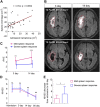Organ- and cell-specific immune responses are associated with the outcomes of intracerebral hemorrhage
- PMID: 28877956
- PMCID: PMC5731128
- DOI: 10.1096/fj.201700324R
Organ- and cell-specific immune responses are associated with the outcomes of intracerebral hemorrhage
Abstract
Severe brain injury significantly influences immune responses; however, the levels at which this influence occurs and which neurogenic pathways are involved are not well defined. Here, we used MRI to measure spleen volume and tissue diffusion changes in patients with intracerebral hemorrhage (ICH). We observed increased capillary exchange and spleen shrinkage by d 3 post-ICH, with recovery by d 14. The extent of spleen shrinkage was associated with brain hematoma size, and a reduced progression of perihematomal edema was observed in the presence of severe spleen shrinkage. At the cellular level, lymphopenia was present in patients with ICH at admission and persisted up to 14 d. Lymphopenia did not parallel the observed spleen alteration. In addition, patients with ICH with infection had significant deficiencies of T and NK cells and poor functional outcomes. Finally, in mouse models of ICH, spleen shrinkage could be related to innervations from adrenergic input and the hypothalamus-pituitary-adrenal (HPA) axis. In sum, the profound impact of ICH on the immune system involves the coordinated actions of sympathetic innervation and the HPA axis, which modulate spleen shrinkage and cellular immunity.-Zhang, J., Shi, K., Li, Z., Li, M., Han, Y., Wang, L., Zhang, Z., Yu, C., Zhang, F., Song, L., Dong, J.-F., La Cava, A., Sheth, K. N., Shi, F.-D. Organ- and cell-specific immune responses are associated with the outcomes of intracerebral hemorrhage.
Keywords: hemorrhagic brain injury; immunosuppression; infection; spleen.
© The Author(s).
Figures




References
Publication types
MeSH terms
Grants and funding
LinkOut - more resources
Full Text Sources

